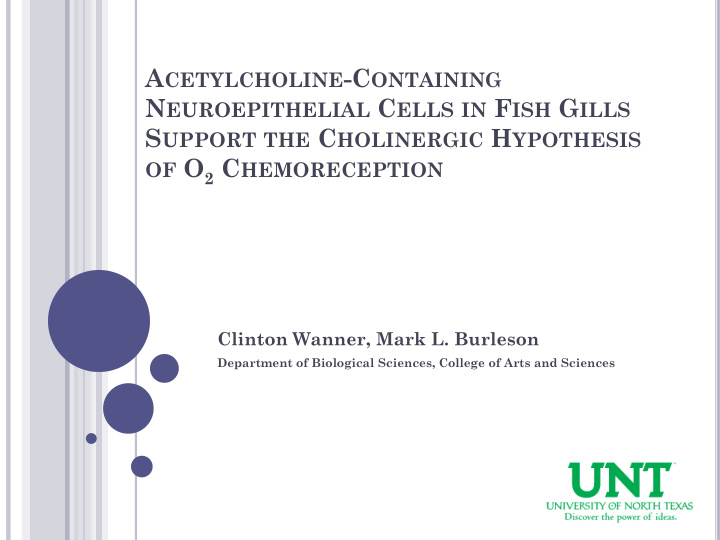



A CETYLCHOLINE -C ONTAINING N EUROEPITHELIAL C ELLS IN F ISH G ILLS S UPPORT THE C HOLINERGIC H YPOTHESIS OF O 2 C HEMORECEPTION Clinton Wanner, Mark L. Burleson Department of Biological Sciences, College of Arts and Sciences
W HY IS O 2 IMPORTANT ? Human survival: 3 weeks without food 3 days without water 3 minutes without oxygen
Environmental O 2 Availability: Dissolved Oxygen in Trinity River, Ft. Worth 240 -2000 200 oxygen partial pressure (torr) Dead Sea equivalent altitude (m) sea 160 level 2290 120 80 5280 Everest 9650 40 0
D ISCOVERY OF O 2 CHEMORECEPTORS Corneille Heymans Nobel Prize in Physiology or Medicine in 1938 Chemoreceptors in cardio-aortic and carotid sinus areas Showed that chemical changes in arterial blood elicited cardio-ventilatory responses. Despite nearly 75 years of research, we still do not understand how O 2 chemoreceptors work!
W HAT ARE O 2 CHEMORECEPTORS ? O 2 chemoreceptors are specialized cells that detect changing levels of O 2 availability and demand and initiate cardiovascular and ventilatory reflexes to maintain normal O 2 uptake. From Lahiri et al., 2001
W HAT ARE O 2 CHEMORECEPTORS ? Hypoxia (low oxygen) depolarizes the O 2 chemoreceptor causing the release of a neurotransmitter. The goal of this study is to identify that neurotransmitter using a non-mammalian animal model. The branchial neuroepithelial cells of fish gills are the evolutionary precursors to mammalian O 2 receptors. From Lahiri et al., 2001
Histochemical Profiles of O 2 Chemoreceptor Cells Amphibians Mammals Birds serotonin serotonin serotonin enkephalins dopamine substance-P neuron-specific enolase norepinephrine neuron-specific enolase tyrosine hydroxylase acetylcholine tyrosine hydroxylase epinephrine Reptiles Fish substance-P serotonin serotonin enkephalins enkephalins enkephalins nitric oxide neuron-specific enolase neuron-specific enolase neuron-specific enolase tyrosine hydroxylase tyrosine hydroxylase tyrosine hydroxylase There is no consensus on the roles of any of these chemicals in the chemoreceptor control of ventilation in vertebrates!
PHYLOGENY Evolution of air-breathing was accompanied by a reduction and internalization of O 2 -sensitive chemoreceptors and their loci. X IX X IX X IX Amphibians Birds Fish Mammals non-Chelonian Reptiles
H YPOTHESIS : B RANCHIAL NEUROEPITHELIAL CELLS CONTAIN ACETYLCHOLINE . This hypothesis will be tested using immunohistochemistry and laser confocal microscopy
C RITERIA F OR N EUROTRANSMITTER : • Presence of the chemical within the cell. The chemical is either synthesized by the neuron or is taken up from other cells that release it. 2 • Stimulus-dependent release. It is released in appropriate quantities by the neuron upon stimulation. • Action on postsynaptic cell . Exogenous application of the substance in appropriate amounts mimics the action of the endogenously-released substance on the postsynaptic cell or organ. Mechanism for removal . [Note, not always included as a criterion] A specific mechanism exists to remove the substance from the synaptic cleft, i.e., by degradation or reuptake.
P REVIOUS S TUDIES : Only acetylcholine consistently mimics the effects of hypoxia and cyanide (histotoxic hypoxia) on cardio- ventilatory reflex responses and neural activity in mammals and fish. Furthermore, the effects are mediated by the nicotinic cholinergic receptor subtype.
M ATERIAL AND M ETHODS Channel catfish ( Ictalurus punctatus ) obtained from TP&W Dundee Fish Hatchery Maintained in 100 gal tanks. On day of experiment, fish anesthetized (MS222), heparinzed, cannulated and gills exsanguinated. Pieces of gill with filaments removed with scissors and fixed in buffered formadehyde Processed, mounted, stained. Observed using Zeiss 200M inverted optical microscope modified for confocal laser microscopy.
G ILL A NATOMY
R ESULTS I MMUNOLABELING OF SEROTONIN
I MMUNOLABELING OF A CETYLCHOLINE
I MMUNOLABELING OF A CETYLCHOLINE
C ONCLUSION Branchial neuroepithelial of catfish gills cells contain acetylcholine. These data support previous reflex and neural studies implicating acetylcholine as the principal neurochemical link between O 2 - sensitve chemoreceptor cells and primary sensory afferent nerves.
A CKNOWLEDGEMENTS Thanks to: Dr. Fuchs Dr. Turnbull David Oden NIH Texas Parks & Wildlife
Recommend
More recommend